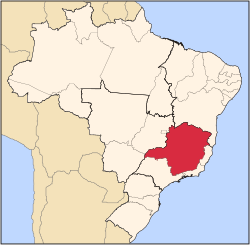This article needs additional citations for verification .(June 2020) |
Tarumirim | |
|---|---|
Municipality | |
 | |
| Coordinates: 19°16′51″S42°00′25″W / 19.28083°S 42.00694°W | |
| Country | |
| Region | Southeast |
| State | Minas Gerais |
| Mesoregion | Vale do Rio Doce |
| Government | |
| • Mayor | Marcilio de Paula Bomfim (DEM) |
| Population (2020 [1] ) | |
• Total | 14,302 |
| Time zone | UTC−3 (BRT) |
Tarumirim is a municipality in east Minas Gerais state, Brazil. It is located in the Vale do Rio Doce region and its population was estimated at 14,302 inhabitants in 2020 (IBGE). It was first founded by the Cunha brothers in 1911 and was named Patrimonio Cunha and Then was considered a Municipality on January 31, 1938 and named Tarumirim an indigenous name that means "Little Sky". City Website:https://www.tarumirim.mg.gov.br/principal
Districts:



